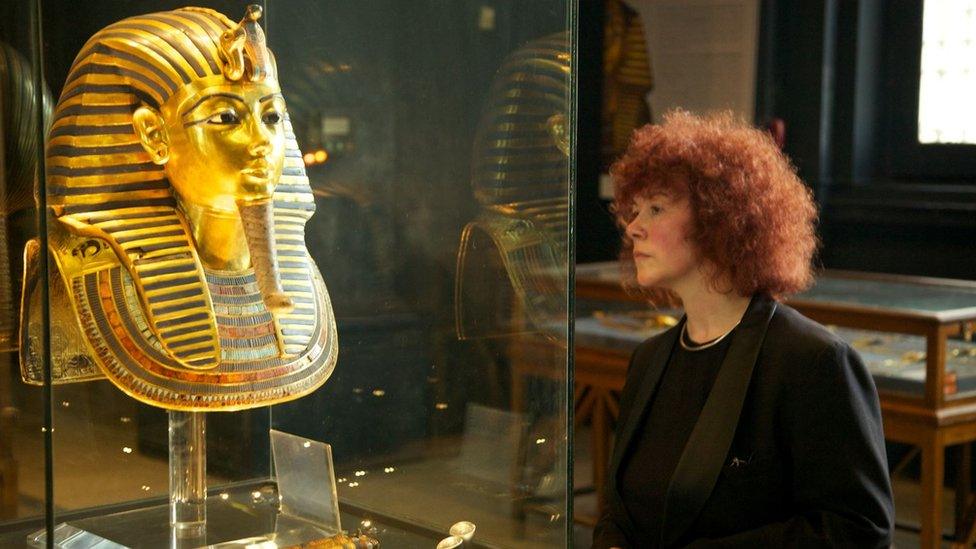Tutankhamun: How a boy from Barnsley helped unearth a pharaoh's tomb
- Published

Tutankhamun ruled Egypt from the age of about nine until his death aged 18
For more than 3,200 years, the tomb of Tutankhamun lay untouched beneath the shimmering sands of Egypt.
But, as a new exhibition opens exploring the boy king's life, one renowned Egyptologist reveals how the flames of one of the greatest ever archaeological discoveries were ignited by a man from South Yorkshire.
The names of the two men who discovered Tutankhamun's tomb are almost as famous as the young pharaoh himself.
After a six-year search, on 4 November 1922 it was British archaeologist Howard Carter who, with the financial backing of George Herbert, the 5th Earl of Carnarvon, unearthed the Egyptian king's final resting place.
Inside were more than 5,000 beautifully preserved items; statues, gold jewellery, chariots, canopic jars and a series of coffins inside which, beneath a glittering, golden death mask, lay the mummified remains of Tutankhamun.

Howard Carter (crouching) discovered the lost tomb of Tutankhamun in November 1922
But, according to Prof Joann Fletcher, an Honorary Research Fellow at the University of York, the discovery may never have been made if it were not for Ernest Harold Jones - a Barnsley-born artist-turned-archaeologist who she believes has been written out of the history books.
Jones, described by Prof Fletcher as an "associate and good friend" of Carter, was sent from the UK to Egypt in 1904 by doctors to help cure his tuberculosis.
An accomplished artist he began by painting artefacts being unearthed in the Valley of the Kings - the royal burial area to the west of the ancient Egyptian city of Thebes.
By 1905 he had swapped his paints for a trowel and began excavating in the area himself.

Born in Barnsley, Ernest Harold Jones faces being written out of the history books, according to Prof Fletcher
During the course of his work he unearthed rings and small objects bearing a strange, new name.
"He found the name Tutankhamun in the Valley of the Kings on numerous occasions," Prof Fletcher said.
"He started to wonder if there was a tomb of someone called Tutankhamun, because at that stage nobody knew that name."
Despite being "hot on the trail" Jones never learned the answer to his question, dying in 1911 aged just 34.
It was his good friends Carter and Carnarvon who organised his funeral.
"They then built on his legacy to eventually discover the tomb of Tutankhamun in 1922," Prof Fletcher said.
"But, as I always say, it was our lad, Harold, Barnsley born, who first lit that fire on the trail to Tutankhamun."
But, while Carter and Carnarvon cemented their place in history, Jones became a forgotten man.

Tutankhamun: Egypt's boy king
Tutankhamun was born in the ancient Egyptian city of Amarna circa 1341 BC
He became Pharaoh of Egypt in about 1332 BC when he was just nine years old
He reigned for about ten years before his death, aged 18, possibly from malaria
His tomb lay hidden for about 3,200 years before it was unearthed in 1922
Tutankhamun's tomb is the only royal tomb from the Valley of the Kings to be discovered relatively intact
Howard Carter spent more than 10 years cataloguing the 5,398 items discovered inside the tomb
Source: BBC/Egypt's Ministry of Tourism and Antiquities


Joann Fletcher said she hoped the exhibition would hoped keep Harold Jones's memory alive
As a young girl Prof Fletcher already marvelled at the colourful pictures and stories of the Egyptians in her parent's books but remembers becoming "besotted" with Tutankhamun during a visit to the British Museum in 1972.
"From the age of six I knew what I wanted to be," she said.
Later, when she discovered the links between her hometown and Egypt the prospect of Jones's contribution being lost to time was not an option.
"I'm Barnsley born and bred so I am biased but, I like to think if Jones lived a little bit longer he was well on the path to making what would be the greatest archaeological discovery of all time," she said.

Prof Fletcher believes Jones's early discoveries were key to Carter's discovery
While Carter and Carnarvon remain immortalised by the treasures they found beneath the blazing Egyptian sun, Prof Fletcher said it was important to remember the people who lay the foundations for their success.
And as curator of Tut' 22: The life of Tutankhamun at Experience Barnsley, she hopes to do that.
The exhibition, housed in a building just a stone's throw from where Jones was born in 1877, explores the life of Tutankhamun while also highlighting South Yorkshire's ties to Egyptian archaeology.
Featuring artefacts from Bolton Museum - themselves collected by South Yorkshire father and son William and Thomas Midgley - Prof Fletcher said she hopes it could inspire the next generation of Egyptologists.
"I think it's celebrating a career cut short, and it's lovely to plant the flag in the sand for Barnsley and Harold," she said.
"It's a story that needs to be told. The man was quite brilliant and completely disappeared from the historical records, which I think is pretty sad, so, hopefully, his name will be known by a few more people after this.
"You don't automatically link ancient Egypt and Barnsley, but I hope now people will think again."
Tut' 22: The life of Tutankhamun' runs at Experience Barnsley from 22 October to 18 March

Follow BBC Yorkshire on Facebook, external, Twitter, external and Instagram, external. Send your story ideas to yorkslincs.news@bbc.co.uk, external.
Related topics
- Published11 May 2022
